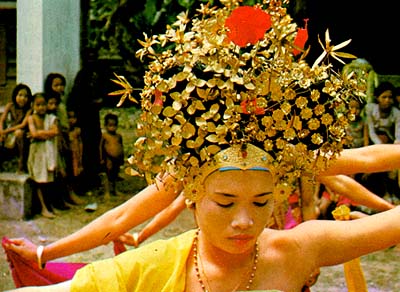
Tenganan
|
|
On a
side-road, leading
inland to the hills near Karangasem, is Tenganan, one of the most
conservative villages of the BaliAga original Balinese. This is a
walled village. Within the bastions, all living compounds are identical
in plan and are arranged in rows on either side of the wide,
stone-paved lanes which run the length of the village. The people of
Tenganan claim to have come originally from Bedulu. The legend of how
they acquired their land dates from the 14th century: the mighty king
Dalem Bedaulu lost his favorite horse and sent the villagers of his
kingdom in all directions in search of it. The men of Tenganan traveled
east and found the corpse of the horse.
|
|
When the
king thereafter
offered to reward them, they requested the land where the horse was
found, i.e. all the area in which the carcass of the dead horse could
be smelt. The king sent an official with a keen sense of smell to
partition the land. For days, the chief of Tenganan led the official
through the hills, yet still the air was polluted with odor of dead
horse. At last, the tired official decided this was enough land and
departed. After he had left, the BaliAga chief pulled from his clothing
a very smelly remnant of the horse's flesh.
|
|
Tenganan
still owns,
communally, these large tracts of well cultivated land. Traditionally,
the men were not accustomed to work in the fields with their own hands
and hired out their land to men of neighboring villages. The
aristocratic Tenganese went to the fields chiefly to collect tuak, a
popular palm beer. The women of this village weave the famous "flaming"
cloth, kamben gringsing, which supposedly has the power to immunize the
wearer against evil vibrations.
|

|
|
Through an
intricate
process of weaving and dyeing, known only here, a single cloth takes
five years to complete. Only the finest pieces are worn by Tenganan
people for ceremonial dress. The imperfect ones are sold, since they
are much in demand throughout Bali.
|
|
During
ceremonies here,
girls, from the age of two, wrap their bodices in silk, don a multi
colored scarf and flowered crowns of beaten gold. Men begin to play the
mysterious melodies of the gamelan selunding, an archaic orchestra of
iron sound-bars, seldom heard outside a few cloistered villages in the
east. Very slowly the girls file out of the darkness, their eyes cast
to the ground. Silently, they lift their scarves and let them fail
again, always moving in slow, dreamlike elegance. This is Rejang, a
ritual offering dance.
|
|
The Fight
of the
Pandanus Leaves at Tenganan takes place only once a year during a
festival called Usaba sambah. To the accompaniment of the sacred
gamelan selunding, two men each within round, plaited shield attack
each other with wads of pandanus leaves, the variety with thorns down
either side of the leaf. The two favorite tactics are to rush and
clench the opponent. The clench has one disadvantage: while one man
rubs this thorny wad across his opponent's back, he is rather open to
the same treatment. Occasionally, the earnestness of an expression
makes one wonder if an insult is not being repaid. During this
festival, Ferris wheels, such as you pass on the road past Klungkung,
are set up on the rising terraces of the village. Some have one wheel
of seats, others two, and the whole wooden contraption is turned by the
foot-power of two men at the tops of the poles on either side.
|
|
Within a
few kilometers
of Tenganan are other conservative and secluded villages that enact,
unchanged, rituals peculiar to them. At Asak, dancers sweep their hair
in a great coil to one side, as seen in old stone statues of
noblewomen. Men play the ancient gamelan gambang of wooden keys. Beyong
Tenganan, the main road crosses a pass overlooking a huge valley. At
the highest point, where drivers often place offerings, a path climbs
steeply up to Pura Gumang and a great view.
|
Copyright
2001-2015, K&D Bali Designs. All rights reserved.
|